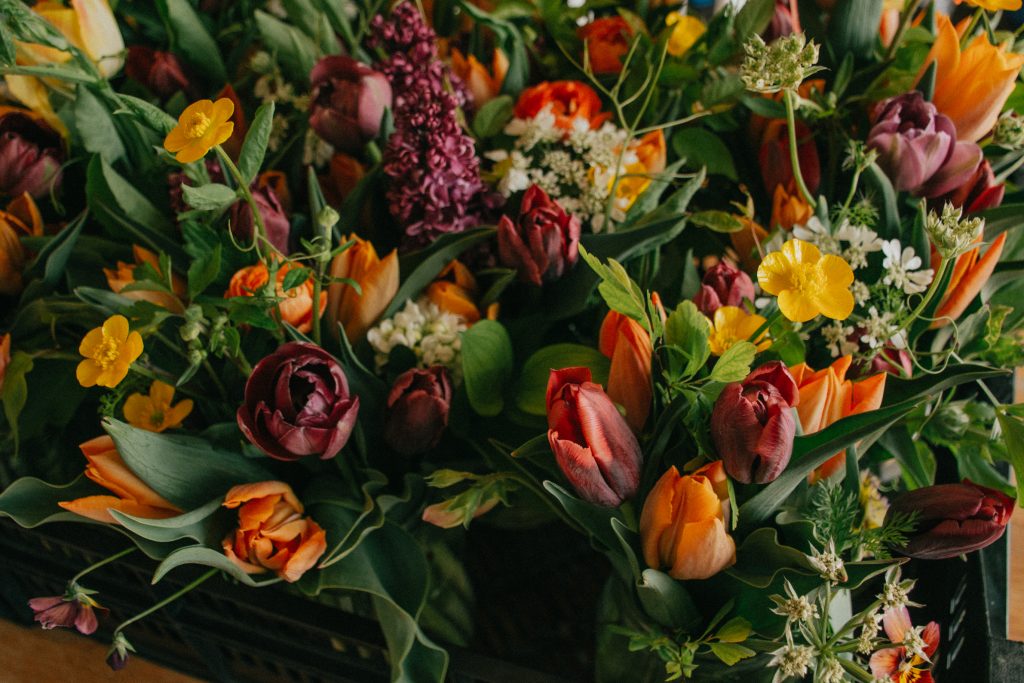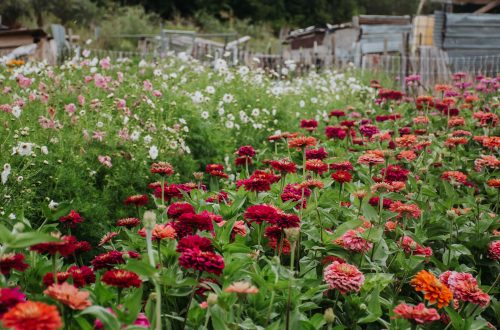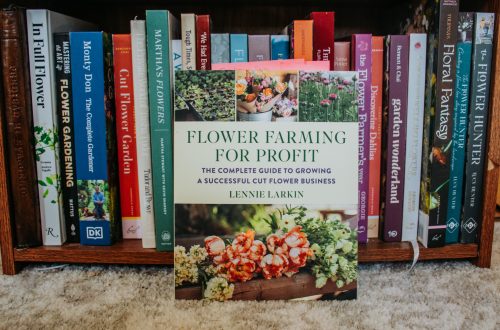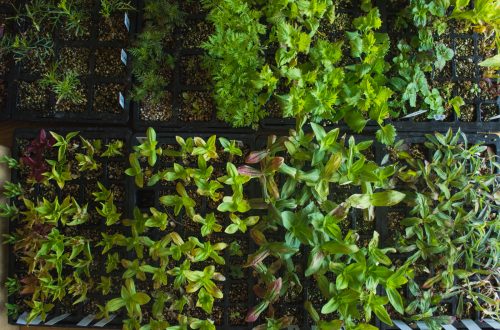
If you’re trying to plan a cut flower garden or flower farm in Utah and wonder what kinds of blooms you can expect in May, then this post is for you! This is also a good list to keep in mind if you’re planning a wedding or other event in Utah and want to use locally grown flowers for that, or if you’re a flower farmer wanting to time your crops for Mother’s Day.
Some important things to consider:
- My data is based on my own experience growing in Central Utah in a high altitude town with a relatively short growing season. Our last frost in the spring is typically in early to mid-June, and our first frost in the fall is usually in late September. I would say that the majority of the more populated places in Utah, such as the Wasatch Front or Utah Valley, are typically around 5-10 degrees warmer than we are at any given point and also have longer grower seasons. Because of that, if you live in one of those places, you will likely need to adjust your own expectations of what’s blooming to be a few weeks ahead of mine.
- I’m only focusing here on what makes for good cutting material in May. There are obviously many other flowers that grow during this month, but I’m not including those here because they’re not something you’d typically use in a flower arrangement. I’m also only focusing on the cutting material that I myself prefer and use.
- Keep in mind that pretty much anything that will be flowering in May will either need to have been planted out the fall before (such as bulbs) or sown in an protected high tunnel or greenhouse structure either the previous year or very early in the year, like January or February. I will try and note below when I usually plant all the things on this list (and where).
- A few of my favorite books for planning out your cut flower garden year month by month are 1 / 2 / 3 (with modifications needing to be made if your climate differs from the authors’ climates). I also like these particular books because they name specific varieties that are among their favorites for cutting.
- I will put the flowers at the beginning of the list that tend to bloom at the beginning of May for us, then go on with the things that bloom closer to June.
Note: There may be affiliate links to books and products mentioned.

May Flowers
Late Tulips
For me, the last of the tulips come on right around or before Mother’s Day every year (perfect timing!), and they’re usually totally done by the middle of the month. Reliable late season varieties include Queen of Night, Dream Touch, Copper Image, and other specialty late flowering varieties like Renown Unique. For me, the Queen of Night tulips are always the very last to come on every season, and as such, they’ve definitely become a staple for us (that, and the dark color blends with nearly everything and offers some great contrast).
Late Daffodils
Daffodils peter out around the same time as the tulips for me, if not just a hair before. The latest varieties are some of the bunch flowering types (like ‘Geranium’ and ‘Yellow Cheerfulness’), anything planted in more shade, and ‘Poeticus’ and ‘Sir Winston Churchill.’ I had my last wave of narcissi for Mother’s Day, and then they were done for the season.

Flowering Branches – Fruit Trees, Spirea
For me, my plum trees are the first to flower, followed by apple and peach (although that just might be placement in our particular orchard area). Our bridal veil spirea consistently starts to come on in the last half of the month, which provides a welcome filler and/or spike when it’s desperately needed.
Leucojum
Leucojum (also called ‘summer snowflake’) is a useful little accent flower that comes up from a fall-planted bulb. The little white bell-shaped flowers in the arrangement below are leucojum (we call them fairy hats), and they add the perfect touch of whimsy and daintiness to anything they’re paired with. They can bloom a bit short the first year after planting, but they get taller each year, not to mention multiply well. These usually produce their last flush of stems the first week or two of May for us.

Lilacs
Lilacs aren’t the longest-lasting cut flower (even if properly conditioned, 4-7 days is considered good), but seriously, nothing beats that fragrance. I especially love using lilacs in event work; just make sure that they won’t be out of water for really any amount of time–these definitely need to be in water constantly in order to hold up well. Not all varieties are created equally, either — some lilac varieties tend to hold up for the full 7 days in the vase, but on others, I’m lucky to get 3-4.
(In case you didn’t know the best conditioning/post-harvest tricks for lilacs, check out this Instagram post I did on it.)
Orlaya
If overwintered successfully (we grow ours in our high tunnel), orlaya is a reliable producer from about mid-May through early July. Filler flowers in spring can be tricky to come by, and I appreciate that orlaya is not only beautiful with its lace-like appearance, but it also adds a nice amount of bulk visually to arrangements (see pic below).

Anemones and Ranunculus
If you’ve either wintered over or started anemones and ranunculus early inside and transplanted them out in January, they tend to be a reliable producer for May. Anemones tend to do much better with our volatile spring temperatures in Utah and will bloom into June for me, but ranunculus are usually sputtering out by the end of the month due to the quickly rising temperatures.
Both are staples for Mother’s Day for sure.
Bleeding Heart
Bleeding heart is a perennial plant that is often overlooked in the cut flower business, but it definitely deserves some space in your plot if you have a bit of extra grow room in the shade to spare. It only blooms for a few weeks, but nothing beats the romantic swoops of heart-shaped flowers in an arrangement (as shown in the Mother’s Day bouquet below). It has a decent vase life of about a week, and I use basically every stem I can off of both my pink and white varieties.

Alliums
Not all alliums will bloom as early as May for me, but some varieties (including the perennial favorite ‘Purple Sensation’) start to come on right around Mother’s Day in our climate. Allium ‘bulgaricum’ is a late May favorite (although it does have the strongest onion smell of any of the ornamental alliums) that pairs nicely with the bearded irises since they consistently bloom at the same time.
Other alliums I like (such as drumstick alliums or ‘azureum’ alliums) tend to not bloom until June.
Sweet Peas
If planted in early winter and grown in a protected structure like a high tunnel, sweet peas will usually start producing by mid-May (sometimes with a few stems even available by Mother’s Day, if you’re lucky!). Some of the daylight sensitive varieties won’t come on that early (such as the Spencer series), but usually I can get some of the more simple, single varieties to really get going in May.

Stock
Stock is kind of a ‘loss leader’ crop for me, but since the fragrance literally sells bouquets, I’m willing to overlook that fact. I start my first successions of stock inside in early to mid January, transplant them out to my high tunnel in mid-February, and those successions will usually bloom for me right around Mother’s Day if we have a decently sunny early spring.
I particularly love the Iron series, as it tends to hold up a little better in our volatile Utah climate. Johnny’s new Stox series has also been a winner.
Columbine
As a native perennial to this region, columbine is an excellent, low-maintenance plant to add to your crops if you can afford the space. I don’t grow a ton of columbine, but the few plants I do have get picked clean every season. I like the McKana Giants series for its larger flowers that act as a great secondary focal (like the white in the bouquet below) and the Barlow series for a stunning accent ‘sparkle’ flower.

Bearded Iris
Admittedly, I’m not a huge fan of bearded irises as a landscape flower, but they are a dang useful cut flower because they’re about the only focal blooming for me at a certain point in May. I have about ten different varieties I grow, and they are definitely a clutch flower for me in that 10-day period when I don’t have any other real focal options to offer between the tulips and the peonies.
Nigella
Nigella comes into full force by early June, but it usually starts blooming for us in late May from a successfully overwintered crop. One great thing about nigella is you really only need to plant it once, and if you let any seed heads form and drop, you’ll have it forever. It can be hard to get a good stem length if not overwintered, but if you are successful at wintering it over, I usually have no trouble getting stems long enough for mixed bouquets or most arrangements. (A great ‘true blue’ flower too, which is always in high demand!!)

Delphinium and Larkspur
Delphinium and larkspur are another crop that are much more prolific in June and July, but if I’ve successfully had some germinate by late fall or early winter in a protected structure, I will usually get the first stems by the end of May. Some of my delphinium that have perennialized out in the field also will start by late May, like this ‘Guardian Lavender’ featured in the bouquet above.
Peonies
I know peonies are traditionally a Memorial Day flower around the state, but we’re lucky to see any of ours start to bloom by the last 4-5 days of the month. They’re definitely more of a June crop for us, but some of the earlier varieties (like Coral Charm) will often be in bloom by the end of May.
Hope you found this list useful, and as always, let me know if you have any questions! I’m happy to help 🙂






